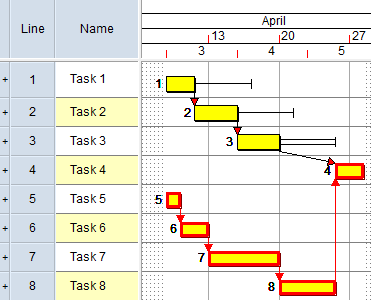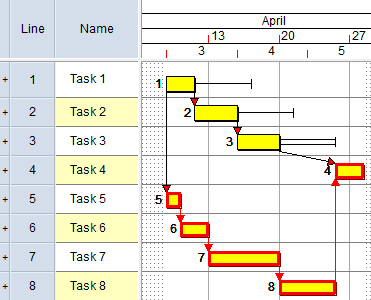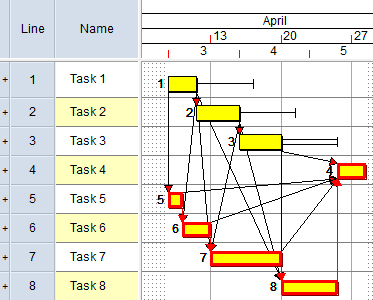'Link logic density' quality metric
Use the 'link logic density' metric to check that a project has an appropriate number of links. This metric divides the number of links by the number of tasks to determine the ratio between these values. A low ratio can indicate that a project does not contain enough logic links; a high ratio can indicate that it contains too many. Each task should have at least one incoming link and one outgoing link, which would give a ratio of links to tasks of 2. For this reason, when counting links for the purposes of this metric, each link is counted twice: once as an outgoing link and once as an incoming link.
If a bar contains more than one task, a task is considered to be linked to its immediate predecessor and/or successor tasks on the bar by "implied links", even if no actual links exist between the tasks, unless the bar is configured to allow tasks to overlap. This metric treats implied links in the same way as normal links.
In the following illustration, there are 8 tasks and 7 links:

For the purposes of this metric, each link is counted twice - once as an outgoing link and once as an incoming link - which gives a total number of 14 links. 14 divided by 8 gives a ratio of 1.75, which means that the above project would fail this metric as there are too few links.
If another link was added to the above example, this would give 8 tasks and 8 links:

Counting each link twice gives a total number of 16 links. 16 divided by 8 gives a ratio of 2.00, which means that the above project would pass this metric as there are enough links.
If 9 more links were added to the above example, this would give 8 tasks and 17 links:

Counting each link twice gives a total number of 34 links. 34 divided by 8 gives a ratio of 4.25, which means that the above project would fail this metric as there too many links.
You can change the impact that this metric has on the weighted total result of a quality check by entering a factor by which the quality metric should be multiplied in the Weighting field. For the weighting to have any effect, a quality check must have more than one quality metric. The result of this metric is turned into a percentage for weighting purposes: if the metric is passed, it is given a percentage of 100%; if the metric is failed, it is given a percentage of 0%. The resulting percentage is multiplied by the weighting factor you specify.
Pass and fail criteria
| Pass or fail? | Criteria |
|---|---|
| Pass | A project passes this metric if the ratio of links to tasks is between 2 and 4. |
| Fail | A project fails this metric if the ratio of links to tasks is less than 2 or greater than 4. |
The following table shows whether some example projects would pass or fail this metric:
| Ratio of links to tasks | Pass or fail? |
|---|---|
| 0.00 | Fail |
| 1.00 | Fail |
| 1.99 | Fail |
| 2.00 | Pass |
| 4.00 | Pass |
| 4.01 | Fail |
| 5.00 | Fail |
Suggested settings
N/A: this metric is either passed or failed.
Does the metric force a project to be rescheduled?
No.
Suggested actions if a project fails this metric
You could take the following actions if a project fails this metric:
- If the ratio of links to tasks is less than 2, add more logic links to the project.
- If the ratio of links to tasks is greater than 4, remove any unnecessary logic links from the project.